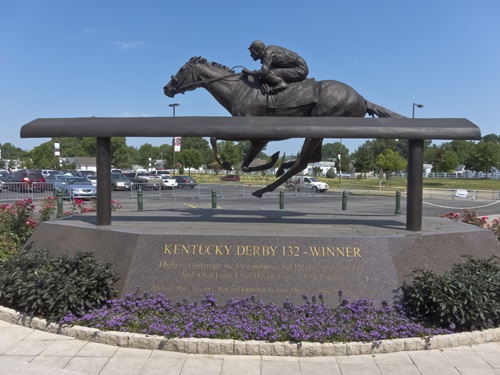
Photo © Cheryl Quigley | Dreamstime.com
Sovereignty, who took the Kentucky Derby in a thrilling finish, won’t be running in the Preakness, but will be seen at the Belmont Stakes.
That’s the word straight from the horse’s mouth, or rather, from a Pimlico Race Course executive, and it effectively ends the Kentucky Derby winner’s bid for the Triple Crown.
Does that make the other two races irrelevant? How to put this nicely? Yes. But also no. A number of compelling storylines should drive attendance, interest, TV viewership and, of course, betting dollars on Saturday, May 17 as the action moves northward and the race for the Black-Eyed Susans begins, despite the fact that those aren't Susies at all.
Sovereignty’s absence stands to loom large. A total of 17 million viewers watched the Derby, which was the biggest audience since 1989, on NBC or streamed on Peacock, notes the Courier Journal.
A part of the decision not to run Sovereignty is the growing awareness within the racing industry of horses’ limitations. According to the Washington Post, it has become increasingly common for Derby winners to skip the Preakness in recent years, as horses typically run less frequently than they used to. Sovereignty is the fourth Derby winner in the past seven Triple Crown seasons to skip the Preakness after all 22 Derby winners from 1997 to 2018 entered the race.
For the record, Justify in 2018 became the 13th horse to win all three Triple Crown races — the Kentucky Derby, Preakness and Belmont Stakes. This year’s Belmont Stakes is scheduled for June 7.

The short turnaround between the Kentucky Derby and the Preakness, traditionally two weeks apart, has increasingly been scrutinized with an eye to horse welfare. And Sovereignty’s trainer, Bill Mott, noted, “Over the years, I think spacing [races] out a little bit gives the opportunity to make [the horses] last a little longer. We’re looking at a career, and you want a career to last more than five weeks.”
Despite the complaints (the loudest of which are coming from those who don’t own or race horses), it’s clear there could be several compelling storylines emerging at the Preakness, according to USA TODAY.
The field is only nine horses deep, as compared to the Derby's 19. The horses that have been confirmed, reporters say, are the following (although it should be noted that the field is not final until post positions are drawn).
Odds via CBS Sports:
- Journalism | early odds: 5-2
- Goal Oriented | early odds: ---
- Sandman | early odds: 8-1
- Clever Again| early odds: 12-1
- River Thames| early odds: 12-1
- American Promise | early odds: 20-1
- Gosger | early odds: 20-1
- Caldera | early odds: 30-1
- Heart of Honor | early odds: 30-1
- Pay Billy | early odds: 30-1
While it's clear Journalism is the horse to beat, it's essential to remember that he was the horse to beat at the Derby as well. The weather might factor in as well; the forecast for Saturday in Baltimore is cloudy with a chance of storms.
Here's some post position trivia from the local NBC affiliate:18 Preakness winners started from the sixth post position. In 1918, 26 horses were entered, causing the race to be run in two divisions for the first and only time in Preakness history.
In the meantime, the racing world continues to grapple with the issue of race timing. Even though the Triple Crown seems sacrosanct to cities who count on the sports tourism aspect of the race, it has become clear that there is a press for change.
“Uh-oh,” noted USA TODAY columnist Dan Wolken, “Is anyone in horse racing going to listen when the best trainers in the world — and the people responsible for the health and well-being of the animal — tell you over and over again that the Triple Crown is no longer viable in its current format? Sorry, traditionalists. But it’s time for the Triple Crown to change.”
Part of it, Wolken noted, is the previously mentioned growing awareness. “This isn’t the 1940s anymore, when it was common for Thoroughbreds to run every couple of weeks and sometimes actually run races in-between the three-week gap separating the Preakness and Belmont. … As much as most fans want to see Sovereignty try for the Triple Crown, Mott holding him out of the race might just be the moment of clarity horse racing needs to finally admit that the current format is no longer in the best interests of the sport.”

Barbaro, the 2006 Kentucky Derby winner, was entered in the Preakness but shattered his leg, breaking it into more than 20 pieces, early on. The injury eventually led to his euthanasia and seemed to serve as a wake-up call, at least to a few people, that the stress on the horses was too much. A memorial to Barbaro stands at Churchill Downs; his ashes are interred beneath it.
Even the Thoroughbred Daily News carried a headline: Enough Already. It’s Time to Fix the Triple Crown. The article that followed proposed a new course of action.
“The solution, as it has been for years now, is obvious. There needs to be more spacing between the races and that doesn't mean just moving the Preakness back a week. The Kentucky Derby should be run on the first Saturday in May, the Preakness on the first Saturday in June and the Belmont on the first Saturday in July. That would mean at least four weeks between each race. In an era where trainers usually want about six weeks between races, even that is not ideal, but it's better than what we have now. Would Mott have elected to run in the Preakness if the race were held on Saturday, June 7? That's five weeks after the Derby. So, the answer is probably “yes.”
Of course, that arrangement could place the Belmont organizers in a precarious position, since the first Saturday in July could easily come into conflict with tourism and activities around the Fourth of July.
Here’s a sure bet: This discussion will continue.

